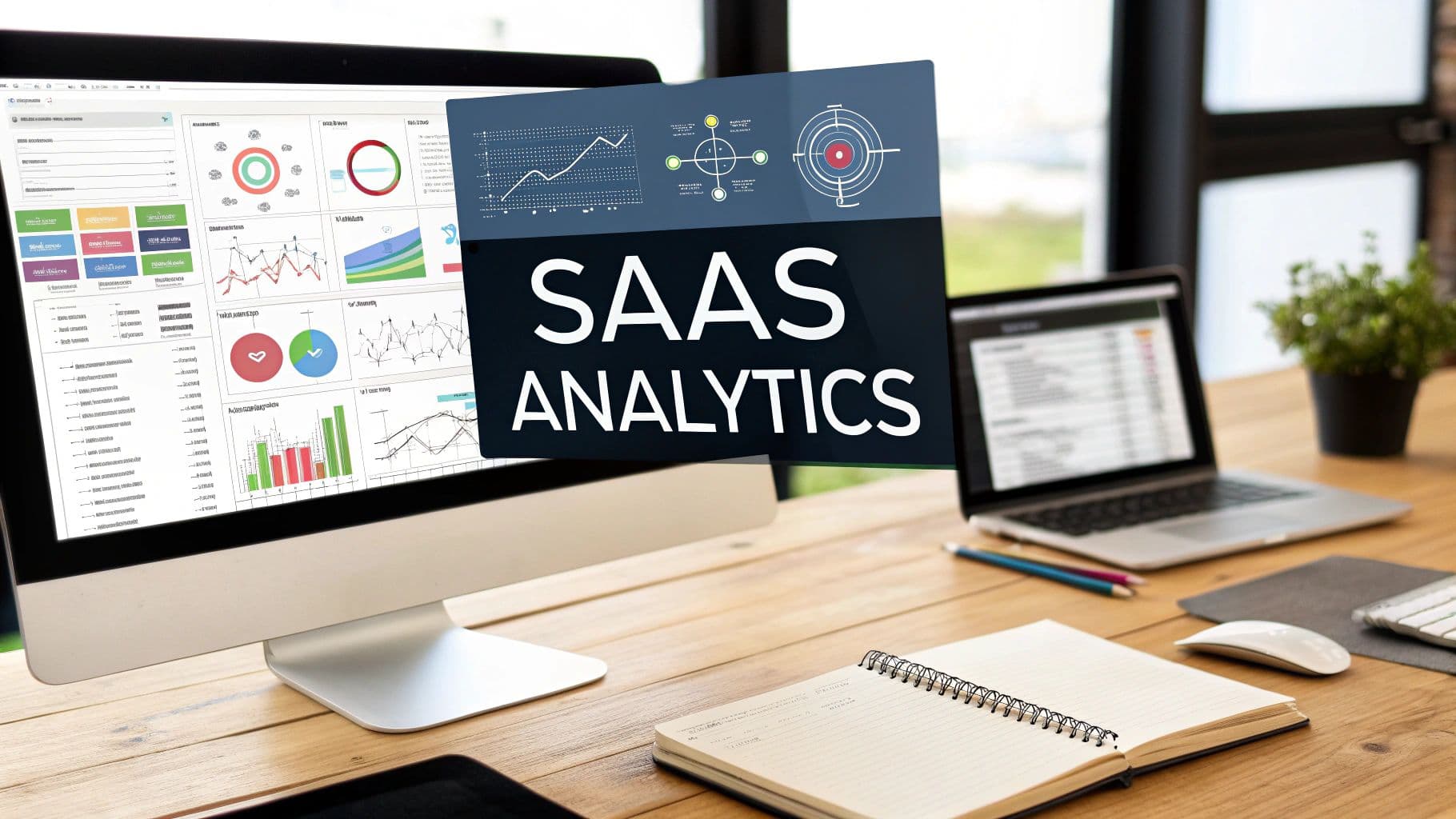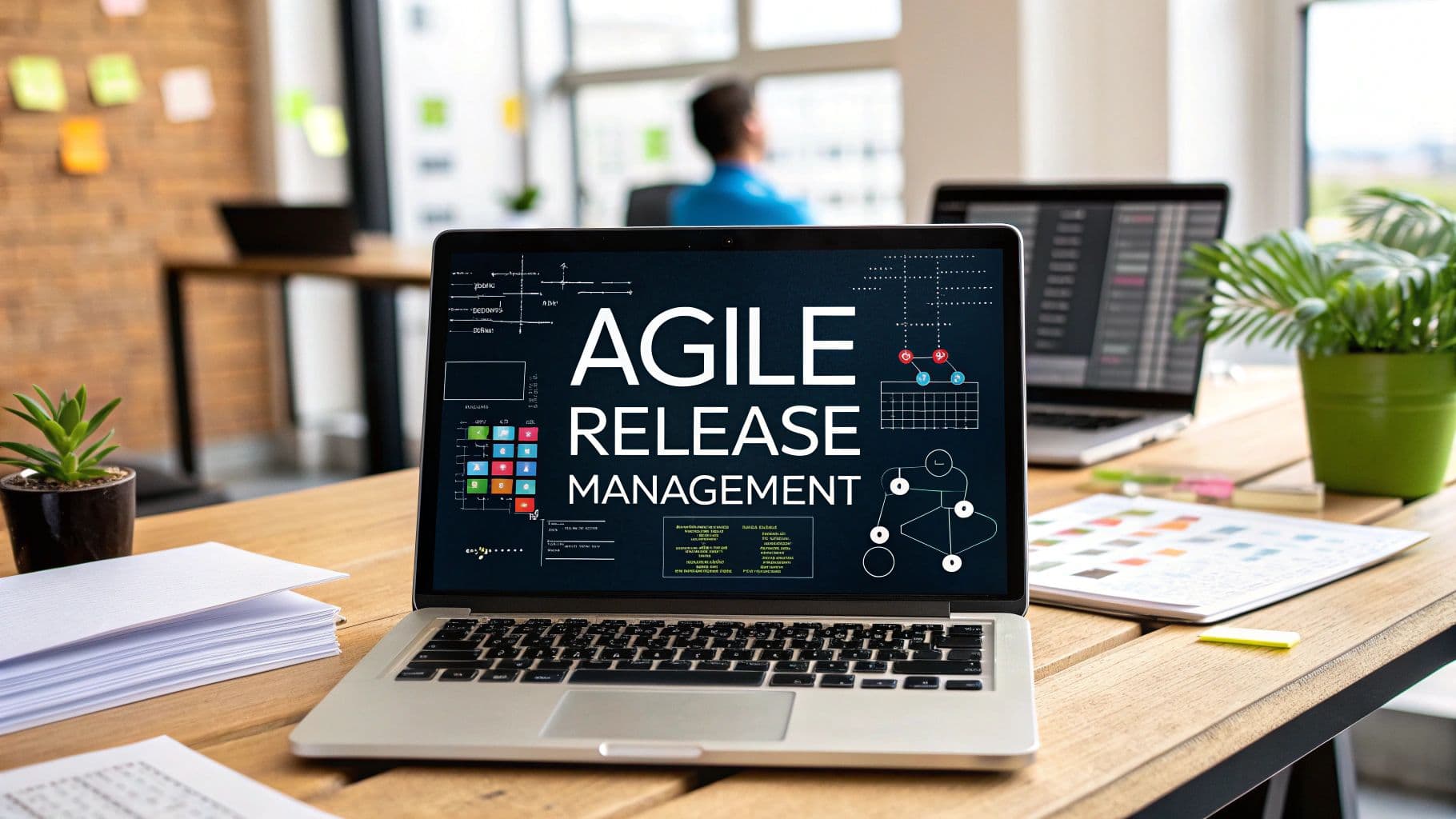saas analytics tools
business analytics
data analysis
product analytics
growth hacking
Top SaaS Analytics Tools in 2025 to Boost Your Business
Unleashing Growth: The Power of SaaS Analytics
Struggling to understand your customer behavior, product performance, or overall business health? SaaS analytics tools provide the critical insights you need to make data-driven decisions and optimize for growth. This listicle dives deep into 12 powerful SaaS analytics tools, offering practical guidance on their features, pricing, integrations, and ideal use cases. From startups to enterprises, we'll help you find the right solution to elevate your performance.
This in-depth review goes beyond surface-level descriptions. We'll explore the nuances of each platform based on extensive usage, highlighting real-world scenarios and honest assessments of limitations. You'll learn which tool excels in specific areas, allowing you to choose the best fit for your unique needs. Gain insights into implementation considerations and discover practical tips to maximize the value of these powerful platforms. Since SaaS analytics tools can be considered a type of SEO tool, you might also find value in this resource on the best SEO tools for small business from That's Rank.
We'll cover these essential SaaS analytics tools:
- Google Analytics 4
- Mixpanel
- Heap
- Tableau
- Power BI
- Matomo
- Kissmetrics
- Woopra
- Amplitude
- Pendo
- Sisense
- Looker
Ready to unlock data-driven growth? Let's explore these powerful SaaS analytics tools.
1. Google Analytics 4
Google Analytics 4 (GA4) is more than just an upgrade; it's a complete reimagining of how SaaS businesses understand their users. Unlike its predecessor, GA4 leverages an event-based data model, providing granular insights into user behavior across both websites and apps. This makes it a powerful SaaS analytics tool for tracking everything from button clicks and form submissions to in-app purchases and video views. It's crucial for painting a comprehensive picture of the customer journey in today's multi-platform world.
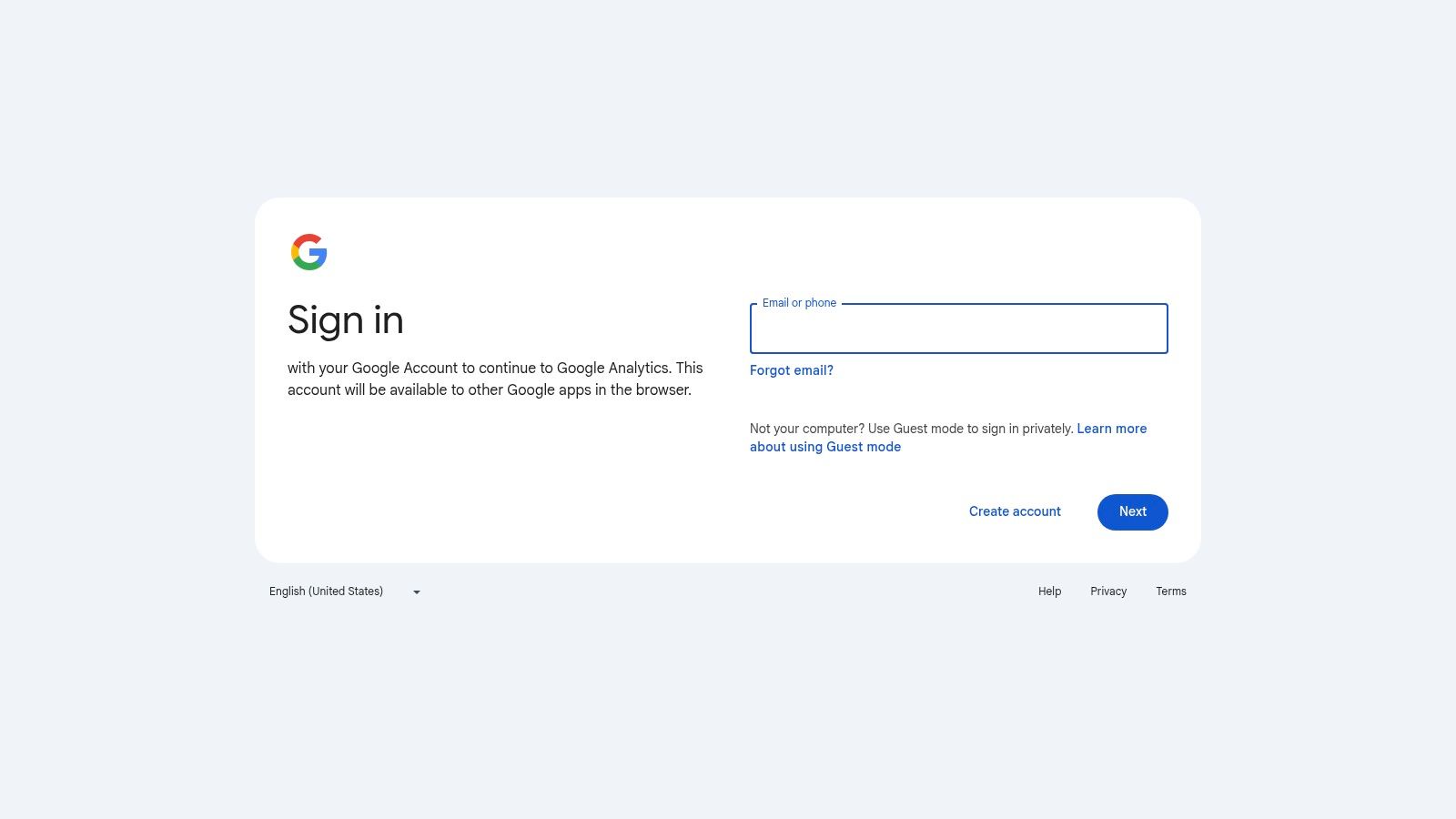
GA4's cross-platform measurement capabilities are especially valuable for SaaS businesses. You can finally see how users transition between your website and app, providing a holistic view of their engagement. This unified data allows for more accurate attribution and a deeper understanding of user behavior throughout the entire lifecycle.
For businesses looking to leverage predictive metrics, GA4 offers machine learning-powered insights to anticipate user churn and potential revenue. This predictive capability helps SaaS companies proactively address potential issues and optimize their strategies for better user retention and revenue growth.
If you're already embedded in the Google ecosystem, GA4's integration with other Google services, like Google Ads and Firebase, is a significant advantage. This seamless integration simplifies data sharing and streamlines campaign tracking and optimization. To understand the broader landscape of data analysis, you may find value in exploring other facets of analytics, like social media analytics.
While GA4 is a powerful, free SaaS analytics tool, its event-based model and new interface can be challenging for users familiar with previous versions. The learning curve is noticeably steeper, requiring some investment in training or exploration to fully utilize its features. Additionally, GA4's limited data retention periods can be a constraint for long-term analysis. Despite these limitations, GA4 remains an indispensable tool for SaaS businesses looking for comprehensive, free analytics. You can access GA4 at https://analytics.google.com/analytics/web/.
2. Mixpanel
Mixpanel is a product analytics platform that helps SaaS businesses understand how users interact with their products. It goes beyond basic website analytics by focusing on in-product behavior, allowing you to track key actions, conversions, and user flows. This makes it particularly useful for optimizing user engagement, increasing retention, and driving feature adoption. It gives product teams the insights they need to iterate effectively and build better products.

Mixpanel's strength lies in its advanced segmentation and funnel analysis capabilities. You can create highly specific user segments based on demographics, behavior, and other criteria, then analyze how these segments move through your product's funnels. This level of granularity is invaluable for identifying friction points and optimizing conversion rates. Many users are curious 'Is Google Analytics Free? Learn the Truth!' from Outrank, as they consider their options for SaaS analytics tools.
Mixpanel's real-time data processing is another key benefit. Unlike some SaaS analytics tools that rely on batch processing, Mixpanel provides up-to-the-minute data, allowing you to quickly identify and react to emerging trends or issues. This is particularly useful for monitoring the impact of new features or marketing campaigns.
While Mixpanel offers a powerful suite of features, it's worth noting its potential cost. For startups and smaller businesses, the pricing can be a significant barrier, especially as data retention limits apply to lower-tier plans. However, for companies prioritizing in-depth product analytics, the investment in Mixpanel can be justified by its ability to drive product improvements and revenue growth. You can explore Mixpanel further at https://mixpanel.com/.
3. Heap
Heap distinguishes itself among SaaS analytics tools with its automatic capture of user interactions. This eliminates the need for manual event tracking, saving valuable development time and ensuring comprehensive data collection from the outset. Heap’s strength lies in its ability to retroactively analyze this automatically captured data, allowing you to uncover insights without predefined tracking. This is invaluable for uncovering unexpected user behavior and identifying friction points you wouldn't have known to look for.
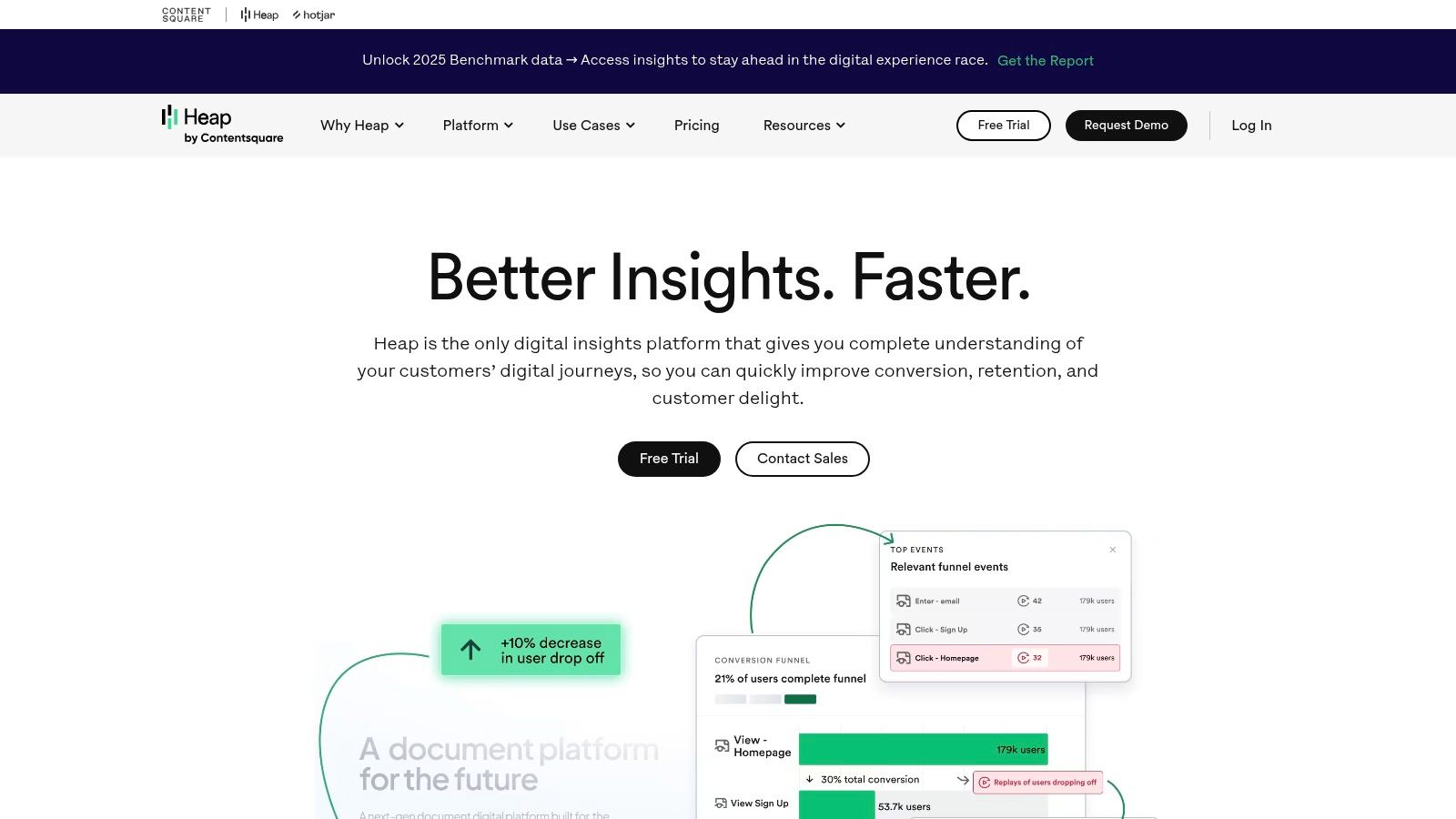
Heap's user journey analysis tools are particularly powerful for SaaS businesses. By visualizing the complete customer journey, you can pinpoint areas of friction that contribute to churn or hinder conversions. This granular level of insight allows for data-driven optimization of onboarding flows, feature adoption, and overall user experience. Real-time data analysis capabilities further enhance Heap's value, enabling rapid responses to changing user behavior.
While Heap offers a robust free trial, its pricing for ongoing use can be higher than some competitors, particularly for growing SaaS businesses with large user bases. The platform's depth of features also contributes to a steeper learning curve, especially for less technical users. Mastering its advanced functionalities requires some investment in training or exploration. Despite this, Heap remains a strong choice for SaaS analytics, especially for those prioritizing comprehensive, automatically captured data and in-depth user journey analysis. You can explore Heap's offerings further at https://heap.io/.
4. Tableau
Tableau is a powerful data visualization and business intelligence tool that empowers SaaS businesses to transform raw data into actionable insights. Its intuitive drag-and-drop interface allows users to create interactive and shareable dashboards, making complex data easily digestible. Connecting to various data sources, including cloud databases, allows for a comprehensive view of your SaaS metrics. Real-time data analysis facilitates faster decision-making and more effective responses to changing market conditions. Consider how Tableau can validate your startup idea. Learn more about how Tableau can help validate startup ideas.

Tableau's advanced analytics capabilities, including predictive modeling, enable SaaS businesses to forecast key metrics like churn rate and customer lifetime value. This foresight is invaluable for proactive intervention and strategic planning. The platform's mobile-friendly dashboards make it easy to monitor performance and share insights on the go, fostering collaboration across teams.
Tableau's flexibility and customization options make it suitable for SaaS companies of all sizes, from startups to enterprises. While the robust features and scalability come at a cost, potentially making it less accessible for smaller businesses, the investment is often justified by the depth of insights gained. Although there is a learning curve, especially for mastering the advanced features, Tableau boasts a strong community and extensive support resources to help users maximize its potential. Its ability to integrate with a wide range of data sources makes it a valuable addition to any SaaS analytics toolkit.
5. Power BI
Power BI, Microsoft's business analytics service, empowers SaaS businesses to transform raw data into actionable insights. Its interactive dashboards and reports go beyond static charts, enabling users to explore data dynamically and uncover hidden trends. This makes it a powerful SaaS analytics tool for monitoring key performance indicators (KPIs), tracking customer behavior, and identifying areas for improvement. For SaaS businesses seeking a robust yet user-friendly analytics solution integrated within the Microsoft ecosystem, Power BI is a strong contender.

Power BI's connectivity to various data sources, including databases, spreadsheets, and cloud services, simplifies data consolidation. This eliminates data silos and provides a unified view of your SaaS business. The AI-powered data modeling features automate complex tasks, allowing users to focus on analysis rather than data preparation. Real-time analytics enable businesses to monitor performance and respond to changes quickly. Looking for more micro-SaaS ideas? Learn more about... using Power BI for efficient analysis.
Seamless integration with the Microsoft Office suite is a major advantage for businesses already utilizing these tools. Data can be easily imported and exported between Excel, PowerPoint, and other applications. While Power BI offers affordable pricing tiers, limitations arise when dealing with extremely large datasets where performance can sometimes lag. Customization options, although extensive, are not as flexible as some competitors. Despite these limitations, Power BI’s user-friendly interface and powerful features make it a valuable asset for SaaS businesses looking to enhance data-driven decision-making. You can explore Power BI further at https://powerbi.microsoft.com/.
6. Matomo
Matomo offers a compelling alternative to Google Analytics, particularly for SaaS businesses prioritizing data ownership and privacy. As an open-source platform, Matomo gives you complete control over your data, ensuring compliance with regulations like GDPR and CCPA. This is a key differentiator for businesses handling sensitive user information. It empowers them to own and manage their data without relying on third-party platforms.
Matomo's strength lies in its detailed analytics, providing real-time data tracking, customizable dashboards, and in-depth reports. Features like heatmaps and session recordings offer valuable insights into user behavior. These features allow SaaS businesses to understand how users interact with their product and identify areas for improvement. E-commerce analytics further enhance its value by tracking sales and conversions.
For SaaS companies looking for a self-hosted solution with no data sampling, Matomo offers unparalleled flexibility. This avoids the limitations and potential inaccuracies associated with sampled data, providing a more complete picture of user activity. However, the self-hosting aspect requires technical expertise for setup and maintenance. This can be a barrier for businesses lacking in-house technical resources.
While Matomo excels in data control and privacy, it does have limitations regarding third-party integrations. Compared to tools like Google Analytics, its integration options are less extensive, which might restrict some functionalities for businesses relying on a complex marketing technology stack. Despite this, Matomo's focus on data ownership and comprehensive analytics makes it a powerful SaaS analytics tool. You can explore Matomo further at https://matomo.org/.
7. Kissmetrics
Kissmetrics distinguishes itself from other SaaS analytics tools by focusing intensely on individual customer behavior rather than aggregated website data. This makes it a powerful tool for understanding the complete customer journey and optimizing for conversions and retention. It goes beyond simple page views and clicks, tracking individual users across multiple touchpoints to provide a granular view of their interactions with your product. This granular approach is particularly valuable for SaaS businesses looking to personalize user experiences and reduce churn.
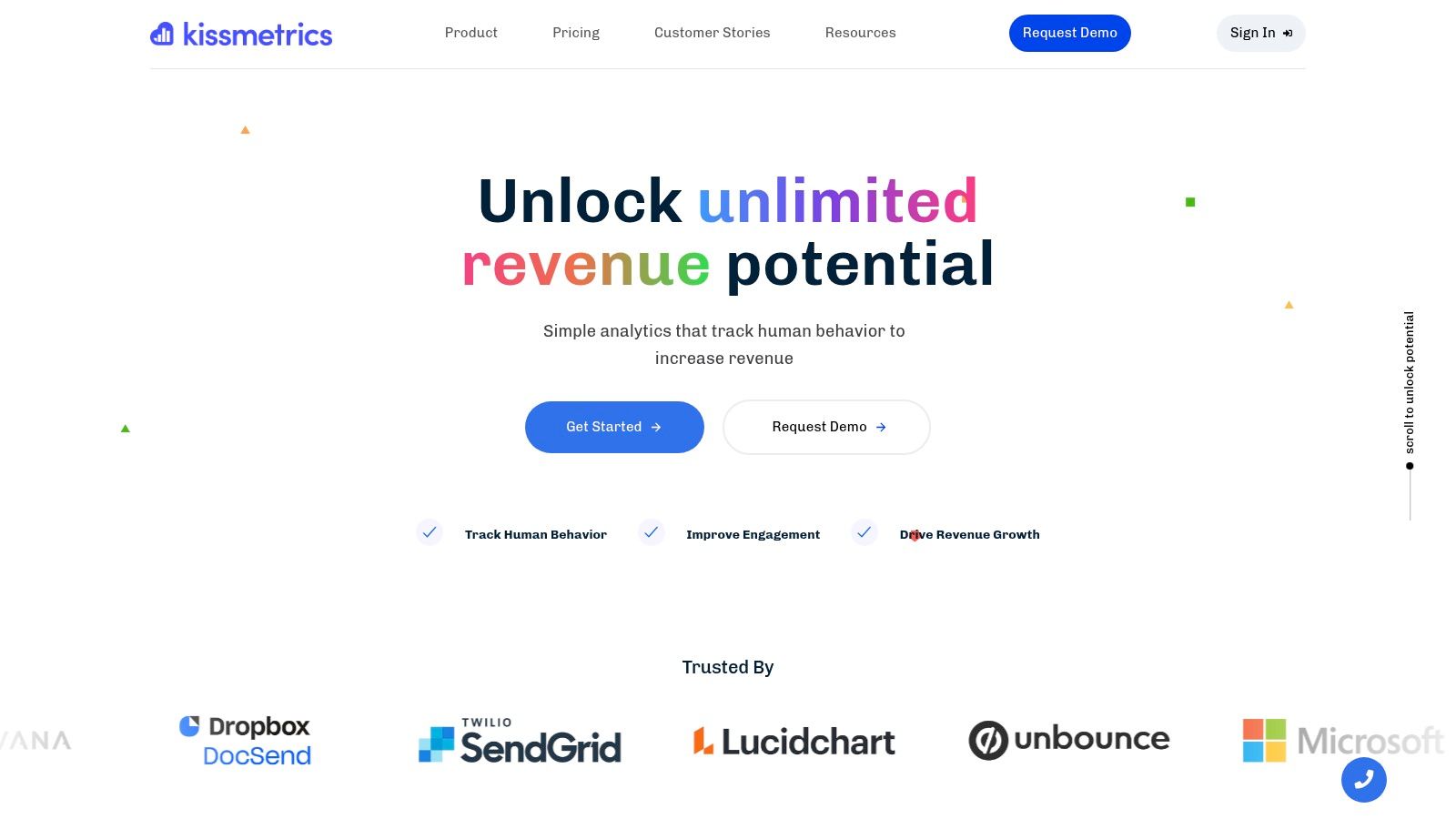
Kissmetrics excels in cohort and funnel analysis. You can easily segment users based on shared characteristics and track their progress through your sales funnel. This helps pinpoint areas of friction and identify opportunities for improvement. Furthermore, the A/B testing features allow you to experiment with different strategies and measure their impact on key metrics. Combined with its robust reporting capabilities, Kissmetrics provides a comprehensive view of your customer engagement.
For SaaS businesses already invested in a marketing tech stack, Kissmetrics offers valuable integrations with various tools. This allows you to streamline your data flow and gain a more holistic understanding of your marketing efforts. However, the higher pricing tiers can be a barrier for smaller startups or those with limited budgets. Also, while Kissmetrics offers historical analysis, its real-time data capabilities are less extensive than some other SaaS analytics tools. Despite these limitations, Kissmetrics remains a powerful option for businesses seeking deep insights into individual customer behavior. You can explore Kissmetrics further at https://www.kissmetrics.io/.
8. Woopra
Woopra stands out among SaaS analytics tools by offering a real-time, unified view of the customer journey. Unlike tools that focus on individual touchpoints, Woopra stitches together user interactions across your website, mobile app, and marketing campaigns. This creates a comprehensive profile for each customer, allowing you to understand their behavior and preferences at a granular level. It's particularly useful for SaaS businesses looking to personalize user experiences and optimize conversion funnels.
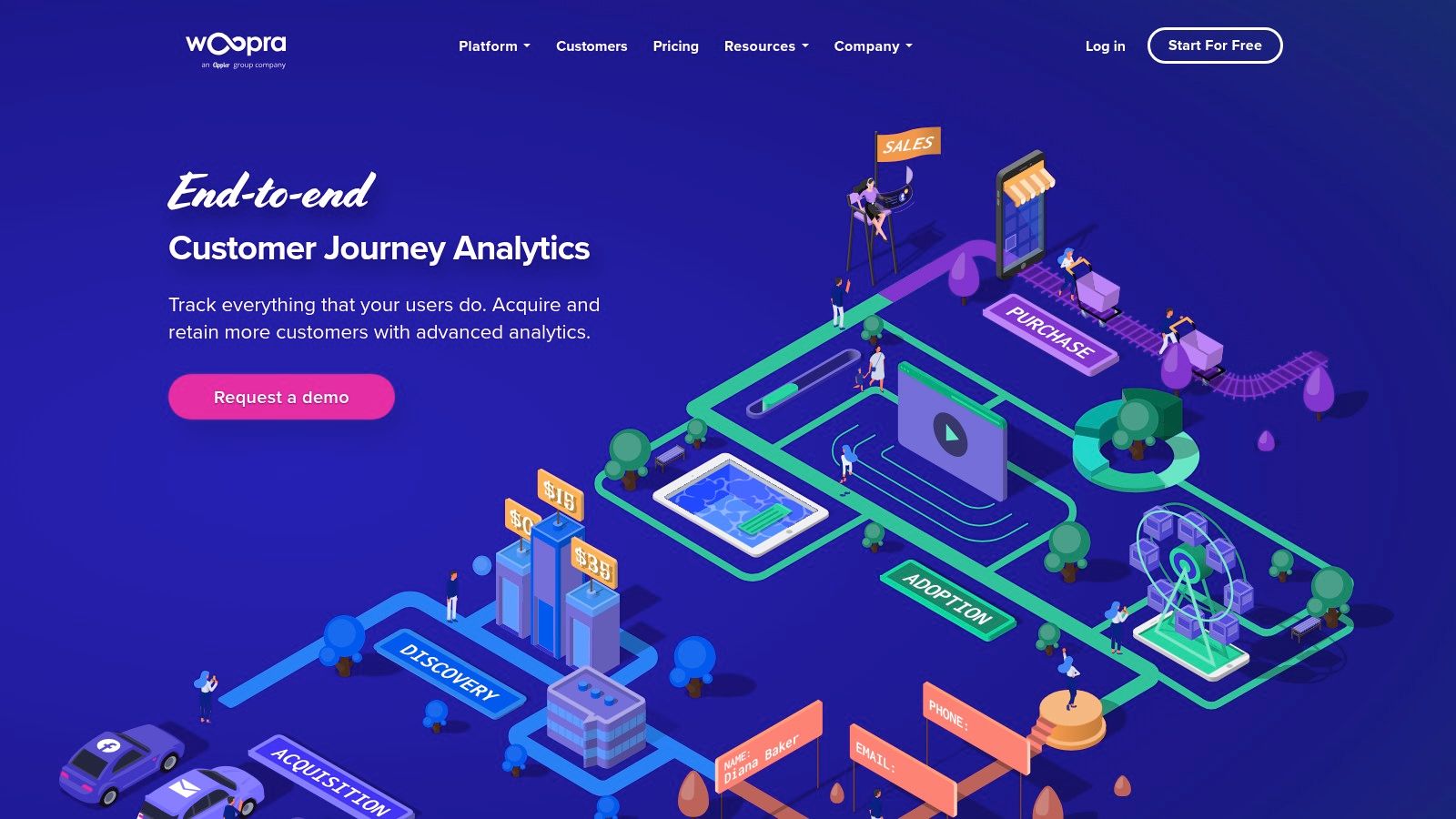
Woopra's customer journey mapping is a powerful feature. You can visualize how users navigate your product, identify friction points, and uncover opportunities for improvement. The platform also offers behavioral segmentation, allowing you to target specific user groups with tailored messaging and offers. Automated triggers and notifications further enhance Woopra's functionality, alerting you to key customer actions in real time.
One of Woopra's strengths is its integration capabilities. It seamlessly connects with popular marketing and sales tools, allowing you to leverage customer data across your entire tech stack. This streamlined data flow empowers teams to make data-driven decisions and improve overall business performance. For SaaS businesses seeking a holistic understanding of their customers, Woopra offers a valuable platform for real-time insights and personalized engagement.
While Woopra offers a powerful suite of features, the limited data retention on lower-tier plans can be a constraint for long-term analysis. Additionally, the pricing can be prohibitive for smaller businesses or startups with limited budgets. You can explore Woopra's features and pricing at https://www.woopra.com/.
9. Amplitude
Amplitude is more than just an event tracker; it's a comprehensive product analytics platform built to help SaaS businesses understand user behavior and drive product growth. Unlike basic analytics tools, Amplitude focuses on the "why" behind user actions, providing deep insights into what features are driving engagement, what's causing friction, and how to optimize the user experience. It's an essential tool for data-driven product development.

Amplitude's strength lies in its robust behavioral cohorting and user segmentation capabilities. You can easily create cohorts based on specific actions, demographics, or any other custom criteria. This allows you to analyze the behavior of different user groups, identify high-value users, and tailor your product strategy accordingly. This targeted approach is invaluable for maximizing user engagement and lifetime value.
For SaaS businesses focused on growth, Amplitude's retention analysis features are crucial. By understanding user churn patterns and identifying drop-off points, you can proactively implement strategies to improve user retention. Amplitude's real-time data processing also allows for quick identification and resolution of critical user experience issues.
While Amplitude offers a free plan, its advanced features and higher data limits come with a significant cost. This can be a barrier for smaller startups or businesses with limited budgets. The platform's complexity can also be daunting for beginners, requiring some time and effort to master its features. Despite these limitations, Amplitude is a powerful SaaS analytics tool that provides the deep product insights needed to drive growth and optimize the user experience. You can access Amplitude at https://amplitude.com/.
10. Pendo
Pendo is more than just a SaaS analytics tool; it's a comprehensive product experience platform. It combines in-depth product analytics with user feedback mechanisms, empowering SaaS businesses to enhance user engagement and boost retention rates. Pendo's strength lies in its ability to provide actionable insights that directly translate into product improvements and a more satisfying user experience. This makes it particularly valuable for product-led growth strategies.

Pendo's key features include in-app guides and messaging, user behavior analytics, feature adoption tracking, feedback collection, and retention analysis. These features work together to provide a holistic view of the user journey. This allows product managers to understand how users interact with their product, identify areas for improvement, and guide users towards successful outcomes.
The platform's user-friendly interface makes it easy to navigate and interpret data, even for those without a technical background. Combined with their strong customer support, Pendo ensures a smooth onboarding experience and ongoing assistance. This focus on usability is a significant advantage for teams looking for a quick and efficient way to gather and analyze product usage data.
While Pendo offers a powerful suite of tools, it does have some limitations. Customization options can be somewhat restricted, particularly in the lower pricing tiers. Additionally, Pendo's pricing can be a barrier for smaller startups or businesses with limited budgets. Despite these limitations, Pendo remains a valuable SaaS analytics tool for companies prioritizing product-led growth and a deep understanding of their users. You can access Pendo at https://www.pendo.io/.
11. Sisense
Sisense is a robust business intelligence (BI) platform empowering SaaS businesses to analyze and visualize complex data, transforming raw numbers into actionable insights. Unlike traditional BI tools, Sisense emphasizes ease of use and speed, allowing even non-technical users to build interactive dashboards and explore data from multiple sources. This self-service approach is particularly valuable for SaaS startups looking to democratize data access and empower teams to make data-driven decisions.
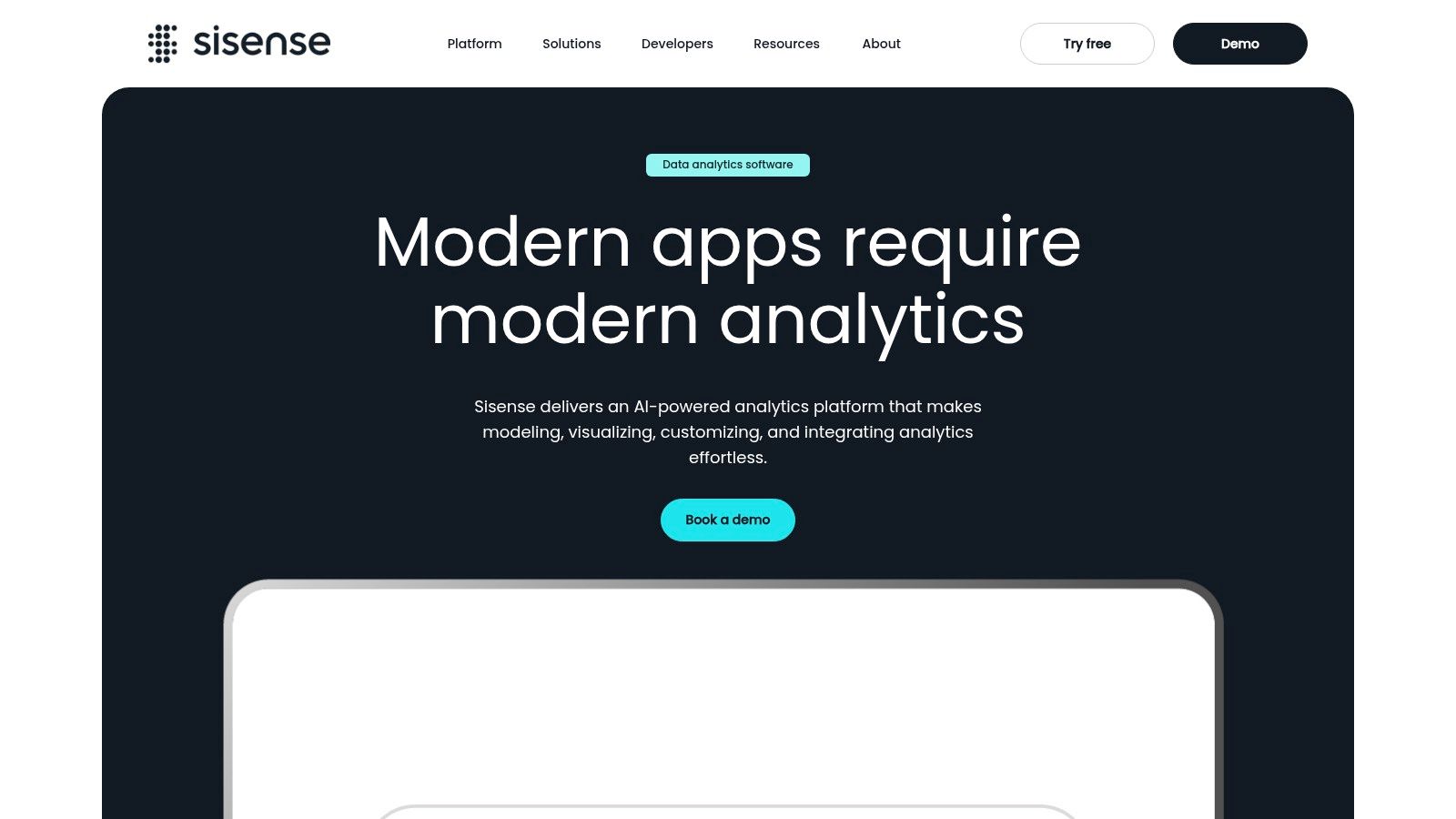
One of Sisense's key strengths lies in its ability to handle large datasets efficiently. Its in-chip analytics technology accelerates data processing, enabling users to quickly generate reports and dashboards even with massive amounts of information. This speed and scalability make it a viable SaaS analytics tool for growing businesses dealing with expanding data volumes. For a broader look at SaaS tools, learn more about Sisense and other b2b saas options.
Sisense's embedded analytics capabilities also deserve mention. You can seamlessly integrate Sisense dashboards and visualizations into your own SaaS application, offering clients valuable data insights directly within their workflow. This white-labeling feature enhances the value proposition of your SaaS product and provides a competitive edge.
While Sisense boasts powerful features, it's important to acknowledge the steeper learning curve compared to some simpler analytics tools. Investing in training or onboarding can be crucial for maximizing its potential. Additionally, its pricing model can be a barrier for smaller businesses or those with limited budgets. Despite these limitations, Sisense remains a powerful SaaS analytics tool for organizations needing robust data exploration and visualization. You can explore Sisense further at https://www.sisense.com/.
12. Looker
Looker is more than just a data visualization tool; it's a powerful business intelligence platform built for in-depth data exploration and analysis. Its strength lies in its robust data modeling capabilities, powered by LookML, which allows you to define and curate metrics consistently across your organization. This ensures everyone is working with the same data definitions, leading to more accurate and reliable insights. For SaaS businesses, this means a single source of truth for key metrics like churn rate, customer lifetime value (CLTV), and monthly recurring revenue (MRR).
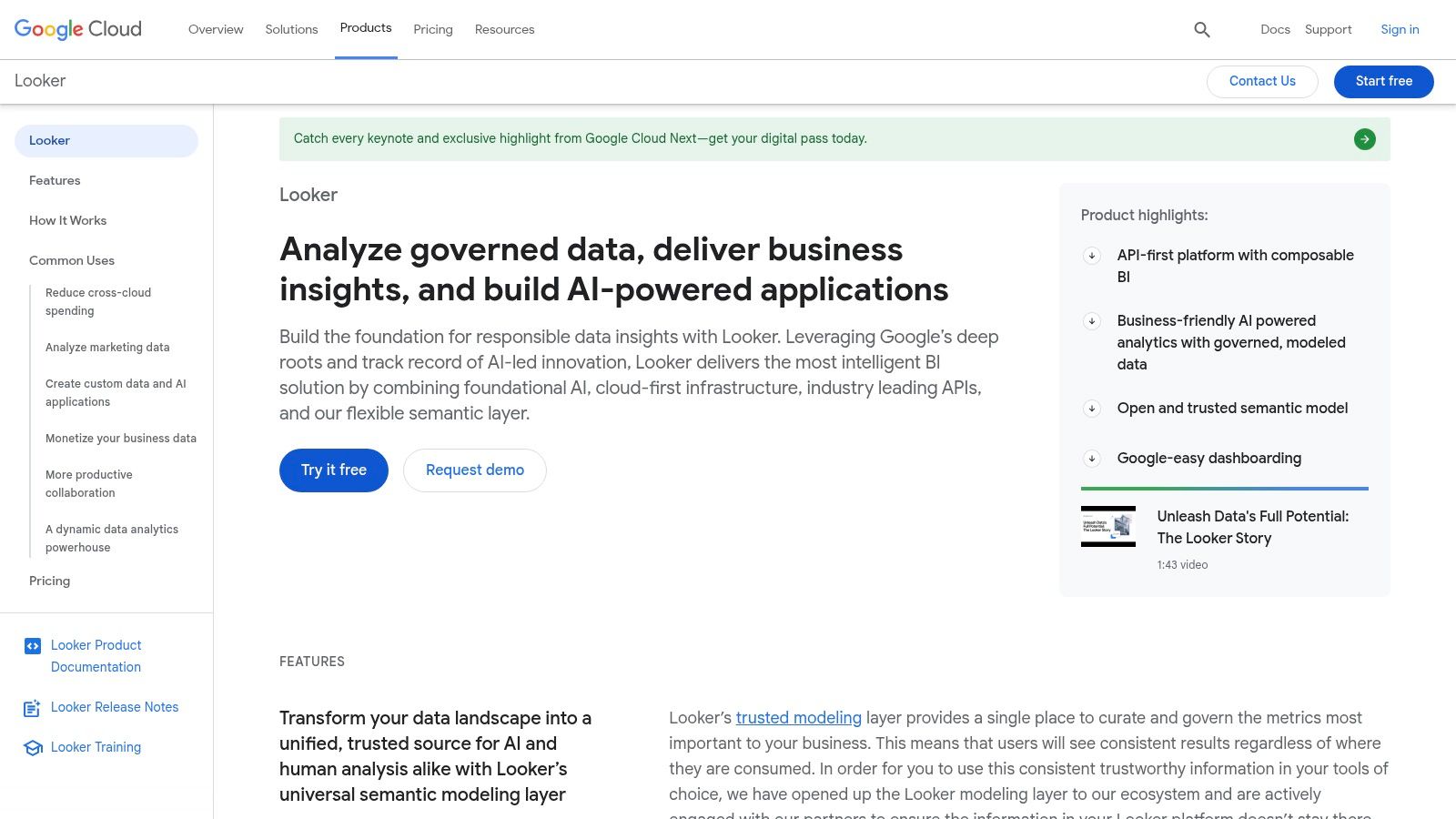
Looker's user-friendly interface makes it accessible even to non-technical users, empowering them to explore data and build custom dashboards without writing complex queries. The platform's real-time data exploration capabilities allow you to quickly identify trends and anomalies, enabling faster decision-making. This is particularly beneficial for SaaS companies needing to react quickly to changing market conditions or customer behavior.
One of Looker's major advantages is its scalability. It can handle large datasets efficiently, making it suitable for growing SaaS businesses. Its embedded analytics functionality allows you to seamlessly integrate data insights into your own applications or customer-facing portals. This provides significant value for SaaS companies looking to offer data-driven insights as a product feature.
While Looker's data modeling language, LookML, is a strength, it also introduces a learning curve, especially for more complex analyses. Additionally, Looker's pricing can be a barrier to entry for smaller startups or those with limited budgets. However, for SaaS businesses needing a robust, scalable analytics platform with strong data governance features, Looker is a worthwhile investment. You can access Looker at https://looker.com/.
Top 12 SaaS Analytics Tools Comparison
| Solution | Core Features / Highlights | User Experience / Quality ★ | Value & Pricing 💰 | Target Audience 👥 | Unique Selling Points ✨ |
|---|---|---|---|---|---|
| Google Analytics 4 | Event-based tracking, cross-platform, privacy focus | ★★★★☆ | 💰 Free, strong Google ecosystem | 👥 Marketers, Web & App owners | 🏆 Cookieless measurement, ML-powered insights |
| Mixpanel | Advanced segmentation, funnels, A/B testing | ★★★★☆ | 💰 Can be costly for startups | 👥 Product teams, SaaS | ✨ Real-time data, customizable dashboards |
| Heap | Auto event tracking, user journey, conversion tools | ★★★★ | 💰 Higher cost | 👥 Data analysts, Marketers | ✨ No manual tracking, quick setup |
| Tableau | Drag-and-drop viz, multiple data sources | ★★★★★ | 💰 Expensive for SMBs | 👥 BI teams, Enterprises | 🏆 Predictive analytics, mobile dashboards |
| Power BI | Interactive reports, MS Office integration | ★★★★ | 💰 Affordable pricing | 👥 Microsoft ecosystem users | ✨ Seamless MS Office integration |
| Matomo | Real-time, privacy-first, heatmaps | ★★★★ | 💰 Open-source/self-hosted | 👥 Privacy-focused users | ✨ Full data ownership, GDPR compliant |
| Kissmetrics | Customer journey, funnel/cohort analysis | ★★★★ | 💰 Higher pricing tiers | 👥 Marketers, Growth teams | ✨ Customer engagement automation |
| Woopra | Real-time analytics, journey mapping | ★★★★ | 💰 Expensive for SMBs | 👥 Customer success, Sales | ✨ Automated triggers, strong integrations |
| Amplitude | Event tracking, segmentation, retention | ★★★★ | 💰 High cost for advanced plans | 👥 Product & Growth teams | ✨ Product-focused analytics suite |
| Pendo | In-app guides, user feedback, retention | ★★★★ | 💰 Premium pricing | 👥 Product managers | ✨ Combines analytics with user engagement |
| Sisense | Data integration, AI insights, in-chip analytics | ★★★★ | 💰 Premium pricing | 👥 BI teams, Enterprises | 🏆 Handles big data, embedded analytics |
| Looker | Data modeling (LookML), real-time exploration | ★★★★ | 💰 Premium pricing | 👥 Data analysts, Large orgs | ✨ Strong data modeling & collaboration tools |
Data-Driven Decisions: Choosing the Right SaaS Analytics Tool
Navigating the landscape of SaaS analytics tools can feel overwhelming, given the variety of options available. From established platforms like Google Analytics 4 and Tableau to emerging solutions like Woopra and Pendo, each tool offers a unique set of features and capabilities. This listicle aimed to provide a practical guide, drawing from real-world usage experience with each platform, to help you make an informed decision.
Key Takeaways and Implementation Considerations
Choosing the right SaaS analytics tool hinges on understanding your specific needs. Consider the following factors:
- Business Goals: What key metrics do you need to track to achieve your objectives? Are you focused on user engagement, revenue growth, or churn reduction? Tools like Mixpanel and Kissmetrics excel at behavioral analytics, while Tableau and Power BI shine in visualizing business performance data.
- Technical Expertise: Your team's technical skills will influence the complexity of the tool you can effectively implement. While Google Analytics 4 offers a relatively intuitive interface, solutions like Looker and Sisense often require more specialized knowledge.
- Budget: SaaS analytics tools come with varying pricing structures. Consider your budget constraints and whether a freemium model, tiered subscription, or custom enterprise solution aligns best with your financial resources.
- Integrations: Seamless integration with your existing tech stack is crucial. Ensure your chosen tool integrates smoothly with your CRM, marketing automation platform, and other essential software. Think about how platforms like Heap, with its automatic data capture, can minimize implementation overhead.
- Data Privacy: With increasing data privacy regulations, understanding how your chosen tool handles and protects sensitive information is paramount. Consider solutions like Matomo that offer on-premise or self-hosted deployment options for greater control over your data.
Making the Right Choice for Your Needs
Remember, there's no one-size-fits-all solution. For startups seeking in-depth user behavior insights, Amplitude might be a perfect fit. Larger enterprises requiring robust data visualization and reporting capabilities might lean towards Tableau or Power BI. Freelancers and agencies might find the simplicity and affordability of Google Analytics 4 more appealing.
Empowering Your SaaS Journey
By carefully evaluating the tools presented in this listicle, considering your specific requirements, and focusing on practical implementation, you can harness the power of data to drive informed decisions. Start by identifying your primary business goals and technical capabilities. Then, explore the tools that align best with these criteria, leveraging free trials and demos to experience their functionality firsthand. The right SaaS analytics tool will empower you to understand your customers, optimize your product, and ultimately achieve sustainable growth.
Building your own SaaS analytics startup? Streamline your development process and create a powerful Minimum Viable Product (MVP) faster with AnotherWrapper. Check out their resources and discover how AnotherWrapper can accelerate your journey to market. AnotherWrapper
Fekri

